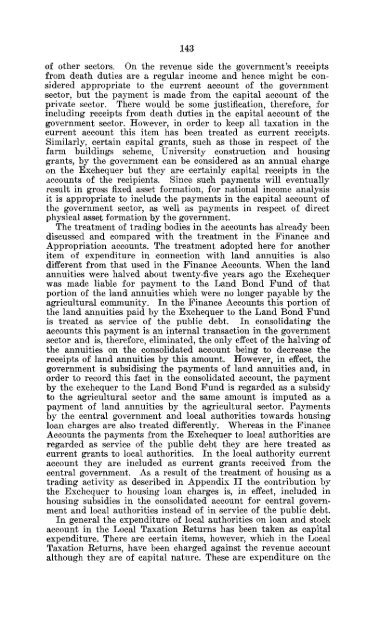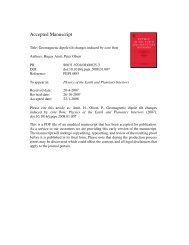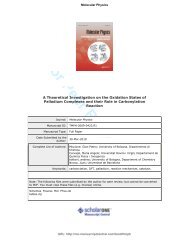An Analysis of Government Revenue and Expenditure in ... - TARA
An Analysis of Government Revenue and Expenditure in ... - TARA
An Analysis of Government Revenue and Expenditure in ... - TARA
You also want an ePaper? Increase the reach of your titles
YUMPU automatically turns print PDFs into web optimized ePapers that Google loves.
143<br />
<strong>of</strong> other sectors. On the revenue side the government's receipts<br />
from death duties are a regular <strong>in</strong>come <strong>and</strong> hence might be considered<br />
appropriate to the current account <strong>of</strong> the government<br />
sector, but the payment is made from the capital account <strong>of</strong> the<br />
private sector. There would be some justification, therefore, for<br />
<strong>in</strong>clud<strong>in</strong>g receipts from death duties <strong>in</strong> the capital account <strong>of</strong> the<br />
government sector. However, <strong>in</strong> order to keep all taxation <strong>in</strong> the<br />
current account this item has been treated as current receipts.<br />
Similarly, certa<strong>in</strong> capital grants, such as those <strong>in</strong> respect <strong>of</strong> the<br />
farm build<strong>in</strong>gs scheme, University construction <strong>and</strong> hous<strong>in</strong>g<br />
grants, by the government can be considered as an annual charge<br />
on the Exchequer but they are certa<strong>in</strong>ly capital receipts <strong>in</strong> the<br />
accounts <strong>of</strong> the recipients. S<strong>in</strong>ce such payments will eventually<br />
result <strong>in</strong> gross fixed asset formation, for national <strong>in</strong>come analysis<br />
it is appropriate to <strong>in</strong>clude the payments <strong>in</strong> the capital account <strong>of</strong><br />
the government sector, as well as payments <strong>in</strong> respect <strong>of</strong> direct<br />
physical asset formation by the government.<br />
The treatment <strong>of</strong> trad<strong>in</strong>g bodies <strong>in</strong> the accounts has already been<br />
discussed <strong>and</strong> compared with the treatment <strong>in</strong> the F<strong>in</strong>ance <strong>and</strong><br />
Appropriation accounts. The treatment adopted here for another<br />
item <strong>of</strong> expenditure <strong>in</strong> connection with l<strong>and</strong> annuities is also<br />
different from that used <strong>in</strong> the F<strong>in</strong>ance Accounts. When the l<strong>and</strong><br />
annuities were halved about twenty-five years ago the Exchequer<br />
was made liable for payment to the L<strong>and</strong> Bond Fund <strong>of</strong> that<br />
portion <strong>of</strong> the l<strong>and</strong> annuities which were no longer payable by the<br />
agricultural community. In the F<strong>in</strong>ance Accounts this portion <strong>of</strong><br />
the l<strong>and</strong> annuities paid by the Exchequer to the L<strong>and</strong> Bond Fund<br />
is treated as service <strong>of</strong> the public debt. In consolidat<strong>in</strong>g the<br />
accounts this payment is an <strong>in</strong>ternal transaction <strong>in</strong> the government<br />
sector <strong>and</strong> is, therefore, elim<strong>in</strong>ated, the only effect <strong>of</strong> the halv<strong>in</strong>g <strong>of</strong><br />
the annuities on the consolidated account be<strong>in</strong>g to decrease the<br />
receipts <strong>of</strong> l<strong>and</strong> annuities by this amount. However, <strong>in</strong> effect, the<br />
government is subsidis<strong>in</strong>g the payments <strong>of</strong> l<strong>and</strong> annuities <strong>and</strong>, <strong>in</strong><br />
order to record this fact <strong>in</strong> the consolidated account, the payment<br />
by the exchequer to the L<strong>and</strong> Bond Fund is regarded as a subsidy<br />
to the agricultural sector <strong>and</strong> the same amount is imputed as a<br />
payment <strong>of</strong> l<strong>and</strong> annuities by the agricultural sector. Payments<br />
by the central government <strong>and</strong> local authorities towards hous<strong>in</strong>g<br />
loan charges are also treated differently. Whereas <strong>in</strong> the F<strong>in</strong>ance<br />
Accounts the payments from the Exchequer to local authorities are<br />
regarded as service <strong>of</strong> the public debt they are here treated as<br />
current grants to local authorities. In the local authority current<br />
account they are <strong>in</strong>cluded as current grants received from the<br />
central government. As a result <strong>of</strong> the treatment <strong>of</strong> hous<strong>in</strong>g as a<br />
trad<strong>in</strong>g activity as described <strong>in</strong> Appendix II the contribution by<br />
the Exchequer to hous<strong>in</strong>g loan charges is, <strong>in</strong> effect, <strong>in</strong>cluded <strong>in</strong><br />
hous<strong>in</strong>g subsidies <strong>in</strong> the consolidated account for central government<br />
<strong>and</strong> local authorities <strong>in</strong>stead <strong>of</strong> <strong>in</strong> service <strong>of</strong> the public debt.<br />
In general the expenditure <strong>of</strong> local authorities on loan <strong>and</strong> stock<br />
account <strong>in</strong> the Local Taxation Returns has been taken as capital<br />
expenditure. There are certa<strong>in</strong> items, however, which <strong>in</strong> the Local<br />
Taxation Returns, have been charged aga<strong>in</strong>st the revenue account<br />
although they are <strong>of</strong> capital nature. These are expenditure on the
















